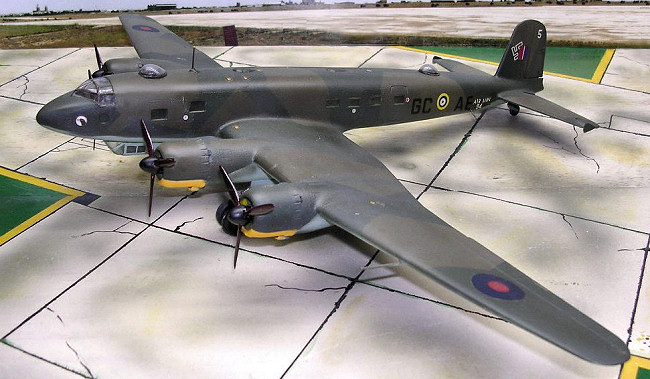
| KIT #: | ? |
| PRICE: | $ |
| DECALS: | See review |
| REVIEWER: | Carmel J. Attard |
| NOTES: | Converted to transport variant |

| HISTORY |
 Regarded as the most
formidable long-range aircraft that was added to the U-boat scourge in the
Battle of the Atlantic, the FW 200 was designed in 1936 by Dip. Ing.Kurt Tank
who was the Technical director of Focke Wulf Flugzengbau G.m.b.H. Initially the
FW200 was intended to be a twenty-six-seat low wing monoplane, designed purely
as a commercial airliner and was powered by four BMW 132 G-1, nine cylinder
radial engines.
Regarded as the most
formidable long-range aircraft that was added to the U-boat scourge in the
Battle of the Atlantic, the FW 200 was designed in 1936 by Dip. Ing.Kurt Tank
who was the Technical director of Focke Wulf Flugzengbau G.m.b.H. Initially the
FW200 was intended to be a twenty-six-seat low wing monoplane, designed purely
as a commercial airliner and was powered by four BMW 132 G-1, nine cylinder
radial engines.
The service
history of the FW Condor was very diverse to include long reconnaissance and
attack anti-shipping missions far out over the Atlantic to the later version
known as the C-6 that was equipped with HS293 missiles that were mounted on
underwing pylons. During the course of its service history, a VIP version also
emerged that was referred as FW200 C-4/u2. These Condors were used by the Fuhrer
Kusur Staffel, which was Hitler's personal tra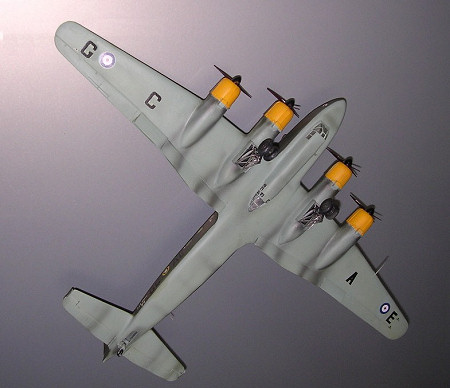 nsport
unit. This special type of Condor was to be used as the personal transport of
the notorious SS leader Heinrich Himmler and was later used as the private
aircraft of Grand -Admiral Karl Doenitz. It was the sole example of the FW200
C-4/UI coded GC-AF number 5, and work No 137 that was built as passenger
transport and at the same time was fully armed and embodying special features.
This incorporated the fitting of two compartments, which jointly could
accommodate 11 passengers. The forward one to be used by Himmler and later
Doenitz. This featured a forward facing armoured plate seat, and a hinged
armoured plate screen for protection from beam attacks. A folding table and a
bookcase were provided in polished wood and there was a jettisonable escape
hatch in the floor in ahead of the seat so that the occupant of the seat would
have a quick way of escape by parachute in the event of an emergency.
nsport
unit. This special type of Condor was to be used as the personal transport of
the notorious SS leader Heinrich Himmler and was later used as the private
aircraft of Grand -Admiral Karl Doenitz. It was the sole example of the FW200
C-4/UI coded GC-AF number 5, and work No 137 that was built as passenger
transport and at the same time was fully armed and embodying special features.
This incorporated the fitting of two compartments, which jointly could
accommodate 11 passengers. The forward one to be used by Himmler and later
Doenitz. This featured a forward facing armoured plate seat, and a hinged
armoured plate screen for protection from beam attacks. A folding table and a
bookcase were provided in polished wood and there was a jettisonable escape
hatch in the floor in ahead of the seat so that the occupant of the seat would
have a quick way of escape by parachute in the event of an emergency.
The forward compartment provided accommodation for 4 additional passengers and the aft compartment could accommodate an additional 6. These two compartments were finished in highly polished light wood paneling with all upholstery being in grey shade.
The one other FW200C-4/U2, work No 138 provided accommodation for 14. The throttle and engine instruments were on a central console and the flight instruments were duplicated on either side for the first and second pilot. The BMW-Bramo 323 R-2 Fafnir, nine-cylinder radial engine powered the version. The FW200 C-4/u2 was flown by Royal Aircraft Establishment, Farnborough, and like its other one, built it featured an abbreviated gondola. The hydraulically operated FW19 forward and aft upper turrets being mounted with a single 7.9mm MG15 machine guns. The VIP Condor had little option but to fly straight and level and the aircraft itself provided a good platform for fighting off the attacker with its heavy defensive armament.
| THE KIT |
The Focke Wulf 200 C was initially released by
Revell circa February 1966. At the time of its release the kit was very welcomed
since it was one of the first axis four engine bomber that could be assembled
straight from the box. Revell's kit represented a FW-200C3/u1, which normally
carried a radar array on the nose. This was omitted from the model probably due
to limitation in the process to inject/mould t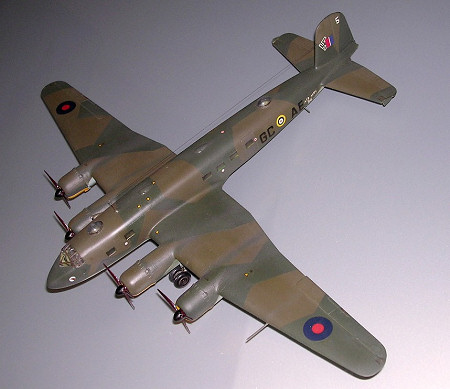 his at the time of its release.
The kit comes with an undercarriage of a sturdy construction when made up in
spite of its complicated design. The control surfaces move, including the flaps,
which carried construction details that show up when in lowered. The model was moulded in light blue plastic, free from flash with the parts fitting well. The
kit also had operable bomb bay doors which when open will expose a bomb bay roof
with several bombs integrally moulded. There are 118 parts. Worth noting is that
the kit was re-released a few years ago (kit 04312) which contained a revised
instruction sheet and decal sheet to represent a FW 200C-4, which operated in
the Mediterranean during 1944. The new format of the decal sheet catered for a
quantity of tiny stencil details that were lacking in the original kit. All in
all a beautiful FW 200 in splinter camouflage can be produced.
his at the time of its release.
The kit comes with an undercarriage of a sturdy construction when made up in
spite of its complicated design. The control surfaces move, including the flaps,
which carried construction details that show up when in lowered. The model was moulded in light blue plastic, free from flash with the parts fitting well. The
kit also had operable bomb bay doors which when open will expose a bomb bay roof
with several bombs integrally moulded. There are 118 parts. Worth noting is that
the kit was re-released a few years ago (kit 04312) which contained a revised
instruction sheet and decal sheet to represent a FW 200C-4, which operated in
the Mediterranean during 1944. The new format of the decal sheet catered for a
quantity of tiny stencil details that were lacking in the original kit. All in
all a beautiful FW 200 in splinter camouflage can be produced.
| CONSTRUCTION |
Converting the FW 200 C-4 into a C4/u1, the VIP
version required a series of alterations particularly to the exterior of the
model. Starting with the fuselage, this carried additional windows bringing a
total of six rectangular windows of equal size to the port side of the fuselage.
This means adding three more windows and blanking the smaller port window
located aft of the crew entry door. Three more rectangular windows are added to
the starboard side but this time retaining the tiny aft window. Note that the
large windows are not in a straight line but not all to the same level. The
small circular window on the port side of the nose is retained but is painted
over. The upper turret on the forward fuselage is removed and its opening
blanked with a piece of plastic card and faired to shape with putty. The
elongated observation canopy mounted on the upper rear fuselage is also removed
and the area blanked as before. In place of these two positions, two smaller
FW19 gun 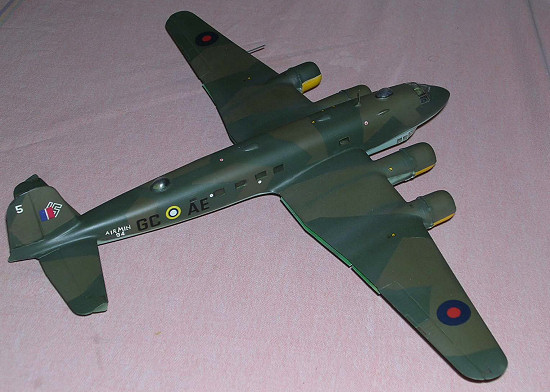 turrets are added. These are round in plan view but have a tear drop
shape when viewed from the side. The centerlines of these two turrets are two
and quarter inches from the fin and two and one eight inches from the nose tip
respectively. Marking these centers then drill a quarter inch hole at each
position to produce the turret opening to the fuselage. I produced these turrets
clear Perspex by first shaping them out of a piece of wood and moulding them on
a gas cooker using a one inch square piece of clear acetate.
turrets are added. These are round in plan view but have a tear drop
shape when viewed from the side. The centerlines of these two turrets are two
and quarter inches from the fin and two and one eight inches from the nose tip
respectively. Marking these centers then drill a quarter inch hole at each
position to produce the turret opening to the fuselage. I produced these turrets
clear Perspex by first shaping them out of a piece of wood and moulding them on
a gas cooker using a one inch square piece of clear acetate.
Making the u/1 version also meant that part of the bay gondola had to be altered by shortening it to a new overall size of four inches. This proved to be a simple task as it involved removing the excess length from the center section of the bay. Ideally the gondola and the bomb doors are first assembled in one piece, and upon drying this is carefully sawn and shortened to the new size. The bomb housings under the inner engine nacelles were filled with putty and carefully blended to conform to the shape of the nacelle. The underwing wing pylons were sawn off and smoothened to level of wing surface.
I have preferred to use a set of sturdy white metal three bladed propellers obtained from Aeroclub. No gun armament was visible attached to the turrets in all the pictures I have examined and so I left these out. My model represented FW 200 C-4/u1, W.No 176.
| COLORS & MARKINGS |
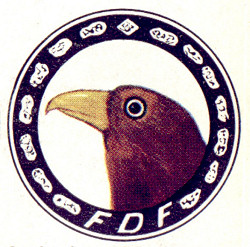 The model was
complete in the standard splinter two tone green camouflage adopted by the
Luftwaffe on top surfaces, and light blue lower with yellow engine cowlings.
(Editor's Note. This would be the maritime scheme of RLM 72/73/65) The
original code letters GC+AE on the fuselage and under the main planes were
ret
The model was
complete in the standard splinter two tone green camouflage adopted by the
Luftwaffe on top surfaces, and light blue lower with yellow engine cowlings.
(Editor's Note. This would be the maritime scheme of RLM 72/73/65) The
original code letters GC+AE on the fuselage and under the main planes were
ret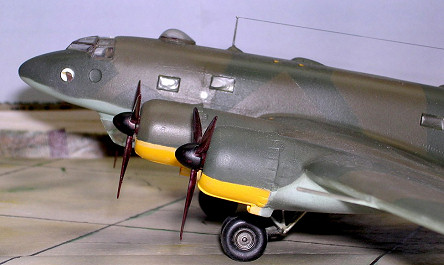 ained but the German crosses were removed and in place RAF roundels added.
The Swastika ensign on the tail fin was partly visible behind the Fin flashes
and so it needs to be retained on the scale model. The 8" Air Ministry No 94 was
made in a straight sequence unlike the port side that was not written in a level line,(to conform that on the real machine) and using similar small white
lettering. The circular Staffel emblem is positioned at same place either side
of the nose. This consisted of a dark brown eagle's head, orange beak over a
white background and circled with a thin black edge. I had to paint this on a
small white decal sheet. For anyone wishing to do the Air Min 97 FW 200C (subvariant
not identified) W.No 0181, this was coded GC+ SJ, and this also carried the
Staffel emblem on the nose and the circular window was also fitted on the
original but again was painted over.
ained but the German crosses were removed and in place RAF roundels added.
The Swastika ensign on the tail fin was partly visible behind the Fin flashes
and so it needs to be retained on the scale model. The 8" Air Ministry No 94 was
made in a straight sequence unlike the port side that was not written in a level line,(to conform that on the real machine) and using similar small white
lettering. The circular Staffel emblem is positioned at same place either side
of the nose. This consisted of a dark brown eagle's head, orange beak over a
white background and circled with a thin black edge. I had to paint this on a
small white decal sheet. For anyone wishing to do the Air Min 97 FW 200C (subvariant
not identified) W.No 0181, this was coded GC+ SJ, and this also carried the
Staffel emblem on the nose and the circular window was also fitted on the
original but again was painted over.
| CONCLUSIONS |
Not that I am keen on Luftwaffe WWII aircraft but in RAF configuration it looked so different and certainly a smart addition to my model collection.
March 2006
If you would like your product reviewed fairly and fairly quickly, please contact the editor or see other details in the Note to Contributors.